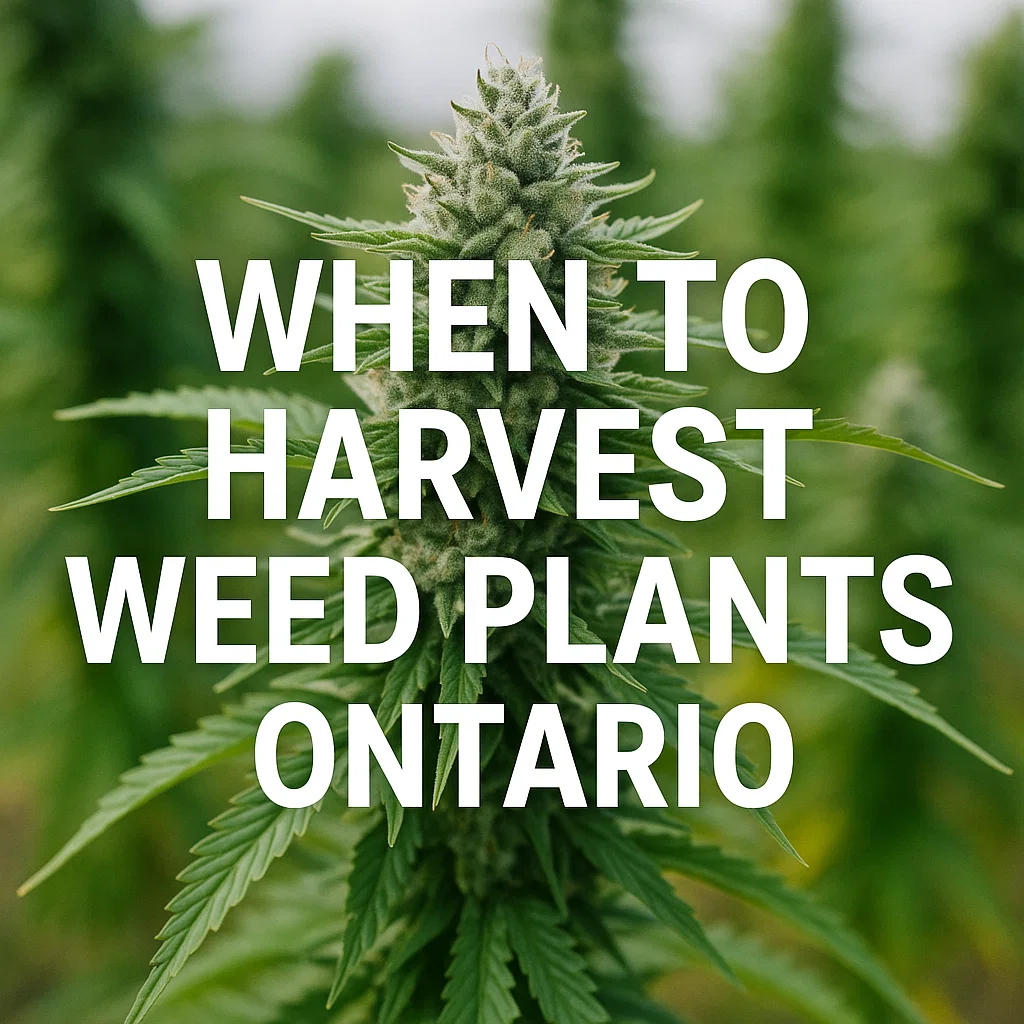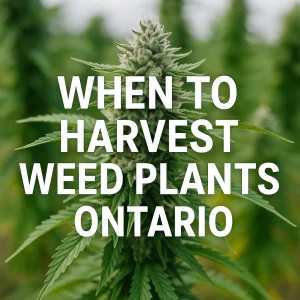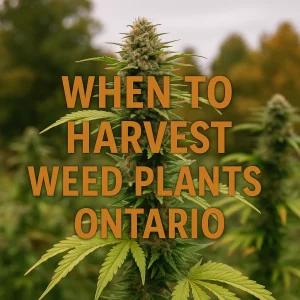When to Harvest Weed Plants in Ontario

When to Harvest Weed Plants in Ontario: A Grower’s Field Guide
If you’re asking when to harvest weed plants Ontario, you’re already halfway to a great crop. Harvest timing is where flavour, smoothness, and potency either come together or slip away. Ontario’s outdoor season is short and shaped by frost, humidity, and late-summer storms, so planning matters. This guide combines practical timelines with hands-on indicators you can trust on harvest day. It also includes a few gear and product tips so you’re ready for drying, curing, and stocking up once the trim is done.
If you need jars, a post-harvest nightcap, or just want to see what’s fresh right now, you can always check our live shop and the rotating posts on the blog.
Ontario’s outdoor clock at a glance
Ontario stretches from Windsor to Thunder Bay, so microclimates matter. Still, most photoperiod cultivars flower on a similar curve once the nights start to lengthen.
-
Southern Ontario (Windsor–London–Niagara–GTA): Flower usually sets hard by mid-to-late August. The prime harvest window often runs late September through mid-October, depending on cultivar and weather. If you’re searching when to harvest weed plants southern Ontario, this is your target range.
-
Central & Eastern Ontario (Barrie–Peterborough–Kingston–Ottawa): Nights cool sooner, so aim for early to mid-October before the first real frost.
-
Northern Ontario: Shorter season with cooler nights. Many outdoor growers plan for late September to early October and favour quicker-finishing cultivars or autoflowers.
Autoflowers, because they’re not tied to day length, can be placed outside in May/June and harvested July through early September. They’re a good hedge against October surprises.

Ontario harvest timing at a glance.
Calendar vs plant signals: follow the plant on harvest day
Dates set expectations; the plant makes the call. Use these four signals together:
-
Trichomes with a loupe
Look at the resin heads on upper buds. Clear trichomes mean “not yet,” cloudy/milky signal peak cannabinoids, and a sprinkle of amber brings heavier, more relaxing effects.-
For an energetic hybrid feel: pull at mostly cloudy, few amber.
-
For a deeper, relaxing finish: wait for 15–25% amber across sample spots.
-
-
Pistil colour and curl
White hairs turning orange/brown and curling in is normal. When 70–90% have darkened on the middle colas (not just the top) and trichomes are cloudy, harvest is near. -
Bud density and swell
Two to three weeks before ripeness the calyxes swell, sugar leaves pull in, and the surface feels tight under your fingers. That final “fill” can add real weight; be patient while watching the weather. -
Aroma shift
The nose gets louder and more complex near the end. If terpene brightness peaks, that’s your sign the plant is ready within days, not weeks.
Rely on trichomes first, then use the other three to corroborate. Checking only the top cola can mislead you in Ontario’s angled sun—always sample multiple buds.
The Ontario problem set: rain, rot, and frost
Bud rot pressure
September humidity plus dense colas is a risky combo. Inspect daily. If you see grey, cottony mould inside a cola, remove the whole affected flower with clean snips and discard it well away from your garden. Do not try to “save” mouldy pieces.
Storms and wind
Tie plants to sturdy stakes before late-season storms. A toppled plant packed with water is a rot magnet.
Frost
A light kiss of near-zero overnight won’t ruin a crop, but a hard frost can burst cells and dull terpenes. If a hard frost is forecast and your trichomes are mostly cloudy, it’s safer to harvest a touch early than to gamble the entire plant.
Emergency ripening tricks
-
Remove some fan leaves a week before expected harvest to improve airflow.
-
If days are cool and damp, consider a staged harvest: take the top colas first and let lower branches finish another 5–7 days.
Regional timing examples
-
When to harvest weed plants in Ontario (Southern): late Sept–mid Oct. A quicker cultivar can be ready the last week of September; longer cookies/kush types may push to Thanksgiving if weather cooperates.
-
Central/Eastern Ontario: first two weeks of October are the sweet spot. If a cold snap looms, pull at cloudy trichomes and finish flavour in the cure.
-
Northern growers: plan around end of September; autos or early-finishing photoperiods shine here.
These are starting points—always confirm with your loupe.
Week-by-week countdown checklist
Three weeks out
-
Start daily trichome checks.
-
Remove dead leaves and tighten plant ties.
-
Gather supplies: pruning shears, trays, gloves, alcohol wipes, hanging lines or racks, hygrometers, and jars.
Two weeks out
-
Watch weather closely. Consider light defoliation for airflow.
-
Reduce nitrogen if you’re still feeding; let the plant use what’s left in the leaves.
One week out
-
Stop all heavy watering right before a rainy stretch.
-
Plan dry space: 15–21°C, 55–60% relative humidity, completely dark, and moving air (not blowing on the buds).
Harvest day
-
Start early while it’s cool and dry.
-
Cut branches, hang whole if space allows, or wet-trim sugar leaves if humidity is high.
-
Keep batches labelled by plant so you can track effects and results later.
Drying and curing in Ontario conditions
Drying is where flavours lock in and harshness disappears. Rushing this step is how great flowers become average.
Drying targets
-
Temperature: 15–21°C
-
Humidity: 55–60% RH
-
Darkness and gentle airflow
-
Time: 7–14 days until stems snap instead of bend
If the week turns humid, run a dehumidifier nearby and position a small fan to move room air (not directly at the flowers). If it gets too dry, hang whole branches instead of wet-trimmed buds to slow the process.
Curing
Once stems snap, buck buds off branches and move them into glass jars. Fill 70–80%, add a 58 or 62% humidity pack, and “burp” the jars daily for the first week: open for 5–10 minutes, then reseal. After the second week, open every few days. A 3–4 week cure noticeably improves smoothness and nose. Two months makes showpieces.
Need jars and a steady “nightcap” while you wait? Many growers keep Premium Pink Kush Indica for a relaxing post-trim bowl and rotate something bright like Sour Diesel Small AAA for daytime energy.
Outdoor vs indoor: what changes
-
Outdoor weed grow: Weather sets the boundaries. Flavour can be huge, but you live with humidity and pests. Timing is a negotiation with the sky.
-
Indoor: You control everything, so harvest timing is mostly about trichomes and the effect you want. The techniques below still apply.
If you’re planning how to grow a pot plant outside next season, pick early-finishing genetics, start indoors so plants are strong by June, and consider a backup autoflower run for a July/August harvest window.
What about “when to harvest a pot plant” that keeps throwing white hairs?
Ontario’s cool nights can cause late foxtailing on the very top buds, which means new calyx stacks and white pistils that never seem to finish. Don’t chase those last hairs. Sample trichomes below the foxtail on the main body of the cola and harvest based on that reading.
Commercial note: what to do with trim and smalls
A thoughtful harvest turns everything into value. Frosty trim can be sifted for kief or turned into solventless rosin if you’re equipped. Popcorn and smalls make great session jars. If you want to stretch your stash while cured jars rest, grab a budget helper like the Quarter LB Premium Smalls Variety Pack so you’re not tempted to break into curing jars too early.
Troubleshooting common Ontario harvest dilemmas
The forecast shows five straight days of rain but trichomes are still mostly clear.
If you can cover plants with a vented canopy and keep airflow high, wait it out. If you can’t protect them and you see rot pressure rising, take the ripest branches and let the rest try to finish. It’s better to bring home 80% excellent than 100% compromised.
Top colas look done but lower branches are lagging.
Do a staged harvest. Take the tops, then give lowers another 5–7 days. They’ll see more light and can finish up while the weather holds.
Buds are big but airy.
Ontario’s late-season warmth can stall calyx swelling. If trichomes are ready, harvest anyway. Airy buds still cure beautifully and taste great when dried slow.
I harvested on time but the smoke is harsh.
That’s usually a dry/cure issue, not timing. Lower your drying temperature, slow the process, and cure longer with humidity control. Harshness almost always softens after a proper cure.
Legal and practical reminders
-
Follow provincial rules for plant counts and possession.
-
Never dry or store in a space with strong odours (kitchen spices, laundry products). Bud is a sponge.
-
Keep drying rooms out of direct sunlight and away from HVAC vents—temperature swings are the enemy of a consistent dry.

Fall cues: colour, weather, and trichomes.
A simple flow you can copy
-
Target window: For when to harvest weed plants in Ontario, circle late Sept–mid Oct in the south, early Oct elsewhere.
-
Confirm with trichomes: Mostly cloudy with a dash of amber.
-
Watch the sky: Protect from rain; act before hard frost.
-
Dry right: 7–14 days at 55–60% RH in the dark with gentle airflow.
-
Cure slow: 3–4 weeks in sealed jars with humidity packs.
-
Enjoy selectively: Don’t crack every jar at once. Keep a separate session stash so your best colas can finish curing.
What to enjoy while you wait
Freshly trimmed growers deserve a reward that doesn’t raid the cure. Pick one or two reliable jars to ride through October:
-
Evening calm: Premium Pink Kush Indica for creamy vanilla pulls and a warm, heavy finish.
-
Daytime lift: Sour Diesel Small AAA for bright lemon-diesel focus while you clean scissors and set up drying lines.
-
Weekend gasser: Purple Jet Fuel if you want that high-octane nose once the work is wrapped.
Prefer variety at a friendly price while your jars rest? The LB Premium Smalls Variety Pack keeps sessions fresh without touching your cure.
Final take
Harvest timing in Ontario is part science, part weather report, and part patience. Use the calendar to set a window—late September through mid-October in Southern Ontario, a little earlier or later elsewhere—then let the plant make the final call with cloudy trichomes and a hint of amber. Protect your buds from September rain, move fast before a hard frost, and put your energy into a slow dry and cure. That’s how you turn months of care into jars that taste like the garden and burn clean.
When your harvest is hanging, celebrate the season with a couple of ready-to-enjoy jars from the shop, then come back to those curing colas when they’re truly ready. Your future self will thank you.

